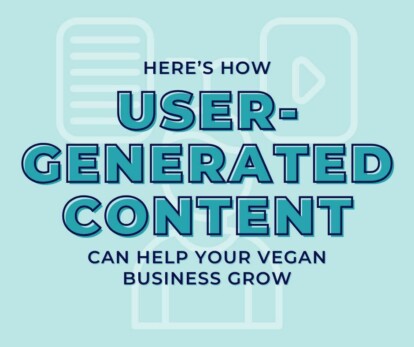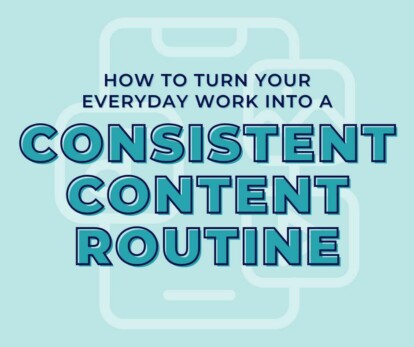How user-generated content can help your vegan business grow


As a vegan business owner, you’re busy. You may have products to create or pack, suppliers to deal with, volunteers to guide, emails to reply to, and a to-do list that never quite gets done.
Somewhere on that list might be the words “post on social” or “write a blog,” but they often fall to the bottom, especially if you haven’t got a clear strategy.
You know you need to pay attention to your marketing, but the pressure to “create content” can feel like an extra job on top of all the others. You might even feel a bit guilty about not showing up consistently online, especially when it seems like other people are really visible in the vegan space, posting clever reels or publishing beautifully written newsletters every week.
But here’s the thing: you don’t need to be everywhere. You just need to show up somewhere that’s popular with your audience, and show up there regularly, in a way that fits your life and values.
This blog will show you how to build a regular content routine by working with your daily activities, not against them. You’ll learn how to:
One of the most paralysing things about content creation is staring at a blank page or screen and feeling like you must pull something brand new out of thin air every single time.
It’s easy to believe that every post or blog needs to be a groundbreaking idea, dripping with originality, and wrapped in flawless visuals. But that mindset sets an impossible bar, and it’s not how most successful ethical content is created!
Instead of starting from scratch every time, start from what you already have.
This could be content you’ve already created or simply life as you’re living it. There is richness in your routines, meaning in your conversations, and beauty in the messy, real-life moments you might be overlooking.
Good content doesn’t need to come from grand ideas, perfectly styled photoshoots, or deep dives into philosophical questions (although those can be powerful too). It can come from a muddy boot print on your morning walk to work, a kind word from a customer, or a moment of connection with one of our animal kin.
In fact, content that feels real, immediate, and human (with all the associated flaws) often performs better than content that’s overly polished. This is especially true in the ethical and vegan space, where trust, transparency, and authenticity matter deeply.
If you start from the idea that content is just sharing, rather than performing, it becomes far less daunting.
Instead of asking, “What should I post today?” you start asking, “What am I already doing that someone else might find valuable, interesting, or uplifting?”
So where exactly can you find this “content-in-the-everyday”? Let’s explore some real-world examples that work across platforms, whether you prefer Instagram, TikTok, blog posts, short-form video, podcasts, or even email newsletters.
Are you preparing parcels for customers, researching a local supplier, cleaning out a goat shelter, or writing policy updates? That’s content.
A quick photo and a sentence or two can become a post. A few thoughts as you do the work can be captured in a voice note or shared as a behind-the-scenes story.
You could turn your day’s activities into:
Think about the questions, debates, or chats you’ve had recently. Did a customer ask how you choose your suppliers? Did a sanctuary visitor ask why you don’t rehome the individual animals in your care? Did a team member raise a valuable point about accessibility?
These everyday conversations are ripe for content. You could share your response as a story, a blog, or a reel. It helps others learn, understand your values, and feel connected to your work.
FAQs are content gold. Turn each common question into its own post, blog, or video. You could even create a series, like “Question of the Week” or “Behind the Label.”
Some examples:
Answering these openly builds trust and saves you time in the future by directing people to existing resources.
People are curious about how ethical businesses operate. Sharing daily or weekly rituals gives insight into your values and helps demystify the work you do.
You might share:
It may seem mundane to you, but to others, it’s fascinating and inspiring. Anything that reflects the small, meaningful steps you take to create positive change is worth sharing. It models a way of life that other people might choose to adopt.
We often feel pressure to only share the polished parts of our lives and businesses. But mistakes and missteps are often what your community relates to most. Talk about what didn’t work, what you learned, and how it shaped your next steps.
Vulnerability can be powerful when shared with care. It shows that you’re learning too, and that growth matters more than perfection.
If a piece of news relates to your mission or sector, consider sharing your take. It might be a recent welfare law change, a controversial ad campaign, or an awareness day.
You don’t need to respond to everything but choosing moments that matter to you helps position your business as thoughtful and aware.
Just be mindful to respond with care and avoid jumping on trends just for visibility.
Let’s be honest: even with all these ideas, it’s still easy to put content creation off if you don’t have a rhythm. Building a cadence is about finding a creation and publishing pattern that works for you. It should feel like a gentle flow, not another pressure.
Here are some ideas to help:
Set your own pace
You don’t need to post daily or even at the same time every week. You could:
Ask: What’s realistic given your current energy and resources?
You may find that recording video footage or voice notes as you work through a task saves you time, but if you don’t want to split your focus, you could block off time dedicated to creating. Notice what works for you and do more of it.
If you’ve ever felt weighed down by the idea that content must go out at the same time each week, take a breath. That old advice about consistency being tied to a strict schedule (“your followers will expect it!”) doesn’t always hold true anymore.
Most people are too busy to notice whether you post every Tuesday at 10am. What matters far more is that you keep showing up somehow – not perfectly, but regularly and with purpose.
Let your rhythm reflect your real life. If that means posting twice in one week and then nothing for ten days, that’s fine. The people who care about your message will still be there. You’re not a content machine; you’re a human being running an ethical business. Make space for that humanity in how you show up online.
Pick 2–3 content pillars
Instead of posting randomly, choose a few themes to rotate between. For example:
When you feel stuck, look at your pillars and choose one to focus on.
Keep an idea bank
Use a tool like Notion, Trello, or a Google Doc to capture ideas as they come (there are some great free templates for these tools to help you). You can also:
Don’t sit down to create from scratch every time. Gather first, then create.
Repurpose your existing content
You pour time, care, and thought into creating meaningful content, especially longer pieces like blogs, podcasts, or videos.
Don’t let all that effort work overtime for just one post and then fade into the background, never to be thought of again. Repurposing is one of the kindest, smartest ways to honour your work and stay visible without burning yourself out.
For example:
This isn’t about repeating yourself; it’s about giving people different entry points to the same core message. Thanks to search and social media algorithms, many people won’t see something the first time you share it, and others need to hear a message more than once to remember it.
Repetition builds trust, and familiarity deepens connection.
(Recent research backs this up. Most people now need an average of 27 interactions or touchpoints with a business before they’ll become a customer, so repeating a message in different ways can help you build those vital touchpoints with your audience.)
If you’re short on time (and let’s face it, who isn’t?), a few tools can help simplify your content planning and creation.
ChatGPT or other AI writing assistants
You can use ChatGPT (or similar tools) to:
Read more in our blog on AI tools for ethical businesses.
Scheduling tools
Use tools like Later, Buffer, Planable, or Meta Business Suite to schedule posts in batches. This frees you from having to post in real-time and gives you a place to park those great ideas that pop up unexpectedly.
You might suddenly think of something perfect for Valentine’s Day, Christmas, or your business anniversary, even if it’s months away. Scheduling tools let you draft and queue that content now, while the idea is fresh, so you’re not scrambling when the moment arrives.
Templates and content calendars
A loose framework for the week or month can reduce decision fatigue. For instance:
You don’t need to stick to it rigidly, but it gives structure.
It also helps to create a batch of branded templates you can reuse. Using a tool like Canva, you can:
When your graphics already look and feel like you, it builds recognisability and saves you loads of time. Instead of designing from scratch, you simply swap in new text or photos and go.
When content starts to feel like a burden, it helps to reconnect with your purpose. Why did you start this business or organisation? What do you want to change in the world? Who are you doing this for?
There is content in the answers to these questions.
Your story matters. Sharing your values and motivations helps others feel part of something bigger. If you’re not sure how to begin, check out our blog on storytelling in vegan marketing.
And remember, content doesn’t have to come only from you. User-generated content can take the pressure off and bring in fresh voices. Invite your supporters to tag you in photos, share their experiences, or write guest posts. Learn more in our blog on how user-generated content can help your vegan business grow.
You’re doing more than you think!
Content isn’t about constant reinvention. It’s about showing up in a way that reflects who you are and what you and/or your vegan business stands for. Whether it’s a short-form video, a blog post, or a photo of a muddy rescue dog, it’s all part of the same bigger picture.
If you need inspiration on where to start, explore our guides on:
Every post you share is a ripple. Keep showing up. Keep telling the truth. You’re already doing the work, now let the world see it.
Our call to action for you? Pick one small idea from this guide and post it this week, then notice how it feels to simply share.